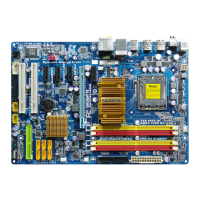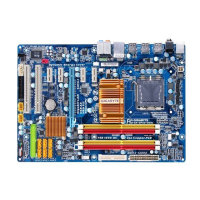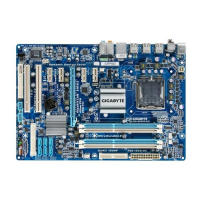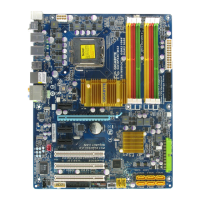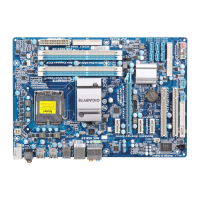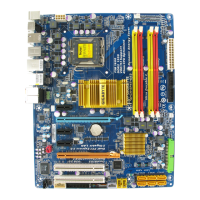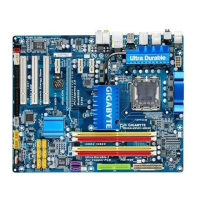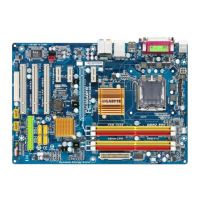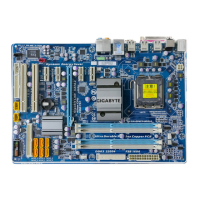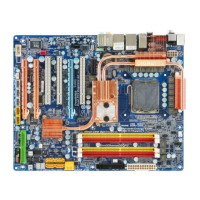Do you have a question about the Gigabyte GA-EP43-DS3 and is the answer not in the manual?
Provides copyright, disclaimer, documentation types, and revision identification.
Details the items included in the motherboard box and optional accessories.
Visual guide to the physical arrangement of components and connectors on the motherboard.
Illustrates the motherboard's internal architecture and data flow.
Essential safety and handling guidelines before installing hardware to prevent damage.
Detailed technical specifications of the motherboard and its integrated features.
Step-by-step instructions for installing the CPU and its cooling system.
Procedures for installing DDR2 memory modules and configuring Dual Channel mode.
Instructions for inserting expansion cards into PCI or PCI Express slots.
Explains the function and usage of all ports on the motherboard's rear panel.
Identifies and describes all internal headers and connectors on the motherboard.
Details the ATX 12V and main ATX power connectors and their pin configurations.
Information on fan headers for cooling and the floppy disk drive connector.
Describes the IDE connector for PATA drives and SATA connectors for storage devices.
Instructions for connecting front panel switches, LEDs, and speaker to the motherboard header.
Guide for connecting front panel audio modules and the CD-IN connector.
Explains the S/PDIF In and Out headers for digital audio connectivity.
Details the USB and IEEE 1394a headers for connecting external peripherals.
Information on LPT (Parallel) and COMA (Serial) port headers for legacy devices.
Explains the chassis intrusion detection header and the CMOS clearing jumper.
Information on the CMOS battery for BIOS settings and the Phase LED indicator.
Describes the LOGO and POST screens that appear during the boot process.
Overview of the BIOS Setup main menu, options, and function keys.
Advanced settings for CPU overclocking, frequency, and voltage adjustments.
Configuration for system date, time, and IDE/SATA device settings.
Options for boot order, CPU features, and system performance tuning.
Configuration of onboard devices like SATA, USB, LAN, and Audio.
Settings for ACPI sleep states, wake-up events, and power-on behavior.
Management of Plug and Play devices and PCI slot IRQ assignments.
Monitoring system temperatures, voltages, fan speeds, and chassis intrusion detection.
Options to restore BIOS settings to Fail-Safe or Optimized defaults.
Setting passwords for BIOS access and system startup protection.
Options to save BIOS changes or exit without saving.
Configuration for the motherboard's security chip functionality.
Lists and describes GIGABYTE utilities and free software from the driver disk.
Access to application guides, descriptions, and related motherboard manuals.
Provides GIGABYTE contact details for technical support and sales.
Displays summary information about the installed hardware and system configuration.
Links to GIGABYTE's website for downloading the latest software and BIOS updates.
Utility for system data backup and restoration.
Introduces GIGABYTE's Q-Flash and @BIOS tools for updating the motherboard BIOS.
Utility for system tuning, overclocking, and hardware monitoring.
Technology for optimizing power consumption and enhancing energy efficiency.
Features hardware-based data encryption and secure key storage.
Tool for sharing data and resources over a local network.
Utility for system data backup and restoration using Volume Shadow Copy Services.
Guide for installing and configuring SATA hard drives, including RAID setup.
Instructions to create a driver diskette for installing SATA RAID/AHCI controllers.
Guide to installing Windows XP/Vista with the required SATA RAID/AHCI driver.
Setup for motherboard audio jacks for various channel configurations and microphone.
Guide for connecting the optional S/PDIF In cable for digital audio input.
Steps for setting up microphone input and adjusting recording levels.
Answers to common questions regarding BIOS options, system power, and beep codes.
A flowchart to diagnose and resolve system startup issues.
Information on environmental compliance, hazardous substances, and waste disposal.
Provides copyright, disclaimer, documentation types, and revision identification.
Details the items included in the motherboard box and optional accessories.
Visual guide to the physical arrangement of components and connectors on the motherboard.
Illustrates the motherboard's internal architecture and data flow.
Essential safety and handling guidelines before installing hardware to prevent damage.
Detailed technical specifications of the motherboard and its integrated features.
Step-by-step instructions for installing the CPU and its cooling system.
Procedures for installing DDR2 memory modules and configuring Dual Channel mode.
Instructions for inserting expansion cards into PCI or PCI Express slots.
Explains the function and usage of all ports on the motherboard's rear panel.
Identifies and describes all internal headers and connectors on the motherboard.
Details the ATX 12V and main ATX power connectors and their pin configurations.
Information on fan headers for cooling and the floppy disk drive connector.
Describes the IDE connector for PATA drives and SATA connectors for storage devices.
Instructions for connecting front panel switches, LEDs, and speaker to the motherboard header.
Guide for connecting front panel audio modules and the CD-IN connector.
Explains the S/PDIF In and Out headers for digital audio connectivity.
Details the USB and IEEE 1394a headers for connecting external peripherals.
Information on LPT (Parallel) and COMA (Serial) port headers for legacy devices.
Explains the chassis intrusion detection header and the CMOS clearing jumper.
Information on the CMOS battery for BIOS settings and the Phase LED indicator.
Describes the LOGO and POST screens that appear during the boot process.
Overview of the BIOS Setup main menu, options, and function keys.
Advanced settings for CPU overclocking, frequency, and voltage adjustments.
Configuration for system date, time, and IDE/SATA device settings.
Options for boot order, CPU features, and system performance tuning.
Configuration of onboard devices like SATA, USB, LAN, and Audio.
Settings for ACPI sleep states, wake-up events, and power-on behavior.
Management of Plug and Play devices and PCI slot IRQ assignments.
Monitoring system temperatures, voltages, fan speeds, and chassis intrusion detection.
Options to restore BIOS settings to Fail-Safe or Optimized defaults.
Setting passwords for BIOS access and system startup protection.
Options to save BIOS changes or exit without saving.
Configuration for the motherboard's security chip functionality.
Lists and describes GIGABYTE utilities and free software from the driver disk.
Access to application guides, descriptions, and related motherboard manuals.
Provides GIGABYTE contact details for technical support and sales.
Displays summary information about the installed hardware and system configuration.
Links to GIGABYTE's website for downloading the latest software and BIOS updates.
Utility for system data backup and restoration.
Introduces GIGABYTE's Q-Flash and @BIOS tools for updating the motherboard BIOS.
Utility for system tuning, overclocking, and hardware monitoring.
Technology for optimizing power consumption and enhancing energy efficiency.
Features hardware-based data encryption and secure key storage.
Tool for sharing data and resources over a local network.
Utility for system data backup and restoration using Volume Shadow Copy Services.
Guide for installing and configuring SATA hard drives, including RAID setup.
Instructions to create a driver diskette for installing SATA RAID/AHCI controllers.
Guide to installing Windows XP/Vista with the required SATA RAID/AHCI driver.
Setup for motherboard audio jacks for various channel configurations and microphone.
Guide for connecting the optional S/PDIF In cable for digital audio input.
Steps for setting up microphone input and adjusting recording levels.
Answers to common questions regarding BIOS options, system power, and beep codes.
A flowchart to diagnose and resolve system startup issues.
Information on environmental compliance, hazardous substances, and waste disposal.
| Number of memory slots | 4 |
|---|---|
| Maximum internal memory | 8 GB |
| Processor socket | LGA 775 (Socket T) |
| Processor manufacturer | Intel |
| USB 2.0 connectors | 2 |
| Power fan connector | Yes |
| Number of COM connectors | 1 |
| Number of SATA connectors | 6 |
| Controller interface type | SATA |
| Controller 2nd interface type | ATA-133/100/66/33 |
| USB 2.0 ports quantity | 8 |
| BIOS type | AWARD |
| Audio chip | Realtek ALC888 |
| Audio output channels | 7.1 channels |
| Motherboard form factor | ATX |
| Compatible operating systems | Microsoft Windows Vista/XP |
| Bundled software | Norton Internet Security |
| LAN controller | Realtek RTL8111C |
| Networking features | 10/100/1000 Gigabit Ethernet |
| Depth | 244 mm |
|---|---|
| Width | 305 mm |
